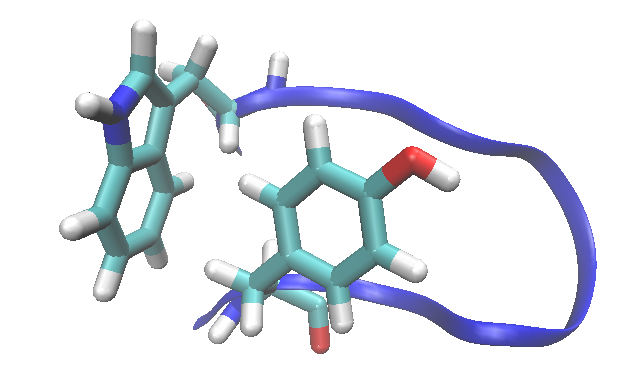Building a Peptide Sequence

Implementation of methods outlined in:
Nguyen, H., Maier, J., Huang, H., Perrone, V. and C. Simmerling, Folding Simulations for Proteins with Diverse Topologies are Accessible in Days with Physics-Based Force Field and Implicit Solvent, J. Am. Chem. Soc., 2014, 136(40), 13959–13962.
Learning Outcomes
Overview
If you want to start a simulation from an extended structure and not based upon an experimentally-determined structure, then the sequence command in LEaP will make this starting structure for you. This short tutorial shows you how to build a sequence, choose the correct force field and save an inputs for sander or pmemd. Note that if you want to run implicit solvent simulations, you will want to specify your radii before saving your topology and input coordinate files. This tutorial uses the 10 amino acid peptide chignolin.Process
1. Start tLEaP with the "tleap" command>$ tleap
-I: Adding /amber20/dat/leap/prep to search path.
-I: Adding /amber20/dat/leap/lib to search path.
-I: Adding /amber20/dat/leap/parm to search path.
-I: Adding /amber20/dat/leap/cmd to search path.
Welcome to LEaP!
>(no leaprc in search path)
A MD force field is the potential energy function that describes the intermolecular and intramolecular forces governing the molecules in the system. Chignolin is a small peptide, made of amino acids. Therefore, a protein force field will need to be chosen to represent the atoms in chignolin. Each type of molecule (protein, DNA, RNA, carbohydrate, lipid, water, ions, co-factors) requires a different set of parameters. To learn more about force fields, please look through section 3.1.1 on page 36 of the Amber 2020 Reference Manual.
In Amber, the standard is that there is both an lib file and a dat or parm file that describes each class of molecule. Lib files can be found under:
$AMBERHOME/dat/leap/lib
Dat and parm files can be found under:
$AMBERHOME/dat/leap/parm
Some premade leaprc files which load a set of lib and parm files for different biomolecules can be found under:
$AMBERHOME/dat/leap/cmd
> source leaprc.protein.ff14SBonlysc ----- Source: /amber20/dat/leap/cmd/leaprc.protein.ff14SBonlysc ----- Source of /amber20/dat/leap/cmd/leaprc.protein.ff14SBonlysc done Log file: ./leap.log Loading parameters: /amber20/dat/leap/parm/parm10.dat Reading title: PARM99 + frcmod.ff99SB + frcmod.parmbsc0 + OL3 for RNA Loading parameters: /amber20/dat/leap/parm/frcmod.ff14SB Reading force field modification type file (frcmod) Reading title: ff14SB protein backbone and sidechain parameters Loading parameters: /amber20/dat/leap/parm/frcmod.ff99SB14 Reading force field modification type file (frcmod) Reading title: ff99SB backbone parameters (Hornak & Simmerling) with ff14SB atom types Loading library: /amber20/dat/leap/lib/amino12.lib Loading library: /amber20/dat/leap/lib/aminoct12.lib Loading library: /amber20/dat/leap/lib/aminont12.lib
Implicit solvent calculations use an electric field to mimic the solvent and the Generalized Born model is a common implimentation. For a thorough discussion of the theory and different parameters, see Cramer and Truhlar. Nguyen et al. employed the GBneck2 parameters.
set default PBradii mbondi3
You should get the tleap message
Using ArgH and AspGluO modified Bondi2 radii
4. Build the chignolin molecule with the "sequence" command
Once we have loaded the appropriate force field into tLEaP, the "sequence" command allows us to connect amino acid "units" together to build a protein, stored here in the "chig" unit. Leap will automatically recognize that GLY1 is the first residues and should be the N-terminus with an NH3+ and that GLY10 should be the C-terminal end with a carboxylate. To learn about other ways to build proteins, please look through section 13.4.2 on pages 222 and 223 of the Amber 2020 Reference Manual.
> chig = sequence { GLY TYR ASP PRO GLU THR GLY THR TRP GLY }
You now have an chignolin molecule stored in the unit chig.
5. Save the chig unit as a pdb file.
To save as a pdb file, type
> savepdb chig chignolin_ext.pdb
You should get
Writing pdb file: chignolin_ext.pdb6. Save the chig unit as parm7 topology files and inpcrd files.
A topology file and a starting set of coordinates are required to run anything with Amber (minimization, molecular dynamics, etc.). This step will save your UNIT (chig) with the appropriate force field parameters (parm7) and starting coordinates (inpcrd file).
To save an Amber parm7 topology file and inpcrd file, type
>saveamberparm chig chig_ext.parm7 chig_ext.crd
You should get
>Checking Unit. Warning: The unperturbed charge of the unit (-2.000000) is not zero. Note: Ignoring the warning from Unit Checking. Building topology. Building atom parameters. Building bond parameters. Building angle parameters. Building proper torsion parameters. Building improper torsion parameters. total 35 improper torsions applied Building H-Bond parameters. Incorporating Non-Bonded adjustments. Not Marking per-residue atom chain types. Marking per-residue atom chain types. (no restraints)
In general when running tLEap, you should run it with the goal of no Warnings or Errors. Anytime an atom is created or a Warning or Error appears, you should review it and make sure it's what you thought should happen. If atoms were added that you don't think should be there, then you did something wrong. Once you quit tLEap, you can also review the leap.log file that is made. Note that the leap.log file is a concatenated log of all your tLEap runs in that folder. So make sure you look in the most recent run.
Above, there's a Warning say that the overall charge is nonzero. This is fine for an implicit solvent calculation. This will not be fine for an explicit solvent calculation. Tutorial 1.4 Building a Protein System walks you through how to add counterions, among other things.
7. Quit tleapTo quit tleap, just type 'quit'
> quit Quit Exiting LEaP: Errors = 0; Warnings = 1; Notes = 1.
You now have an extended starting set of coordinates (chig_ext.crd) and a parm7 topology file (chig_ext.top) that you can use to run an implicit solvent calculation. If you don't want to use GBneck2, then skip step 3 or substitute with the preferred radii. It should be noted that because of the limits of the Ergodic hypothesis, lack of sampling, that most people in the field begin from an experimental structure.
by Jan Ziembicki and Maria Nagan

